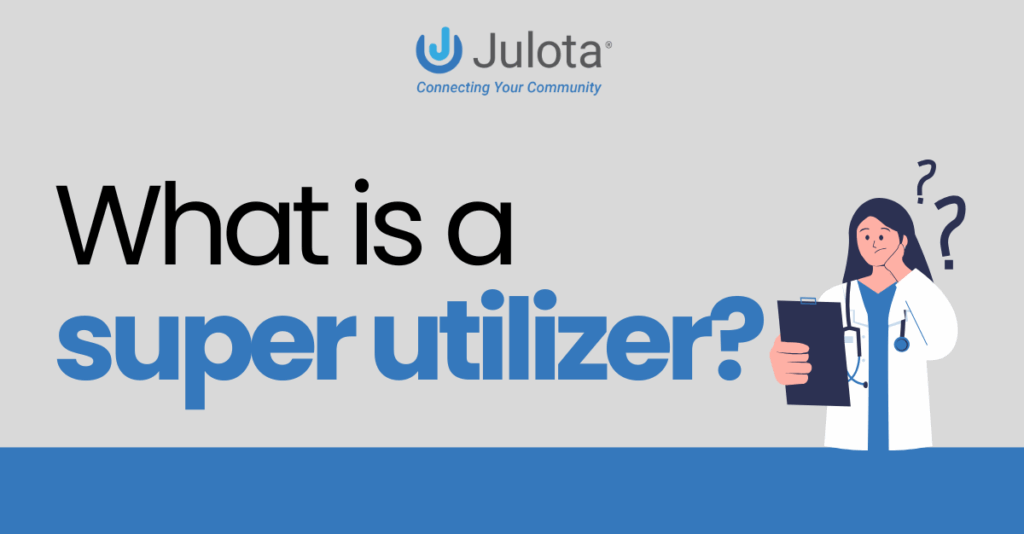Have you heard the term “super-utilizer” in relation to healthcare and wondered what it means? In this guide, we will discuss who is classified as a super-utilizer and how this classification impacts healthcare.

A super-utilizer is an individual who accesses the healthcare system, particularly emergency rooms or ambulance services, at a rate significantly higher than average. Historically referred to as “frequent flyers,” these individuals may call 911 or visit the ER multiple times a week.
While the term super-utilizer is now more commonly used in policy and healthcare discussions, many communities are moving toward more person-centered language, referring to these individuals as familiar faces or even customers in an effort to reduce stigma and promote respectful engagement.
We’ll discuss what a super-utilizer is, what causes them, and how healthcare systems can work to address this issue.
What is a Super-Utilizer in Relation to EMS and Emergency Rooms?
A super-utilizer is a person identified to use the EMS system or hospital emergency room at a rate that far exceeds the average. Where most people might go to the ER once a year, super-utilizers will go to the ER multiple times a month.
In the following few sections, we’ll go over the details that coincide with people classified as super-utilizers.
Here are some of the characteristics of a super-utilizer:
- Reduced Access to Preventative Healthcare
- May be Homeless or Near-Homeless
- Might be Struggling with Substance Use and Addiction
- Often have Mental Health Struggles
- Can Have Uncontrolled Chronic Diseases
- Often Go Overlooked and Non-Prioritized
Super-Utilizers Often Have Reduced Access to Preventive Healthcare
One characteristic of almost all people who might be classified as super-utilizers is that they don’t have access to (or awareness of) preventative care. Some people have classified super-utilizers as “system abusers” because they believe that they are taking advantage of the emergency system.
While there are certainly instances where someone might not be acting correctly, it is often not so much that they are failing the system as the system is failing them. People who frequently access 911 and the ER usually lack knowledge or access to the available systems. These people might have chronic pain or mental health issues, but don’t have anywhere to turn for help.
Since the emergency system is widely known and available, that’s where people end up. Indeed, some people want to continue returning to the ER, but some people would be interested in other forms of help if they knew it was available. That’s what MIH-CP tries to offer: another pathway for help.
Super-Utilizers May be Homeless or Near-Homeless
Another characteristic of super-utilizers is that they are often homeless or have a very unstable home situation. They may be living in their car or bouncing from house to house, with no potential stability in sight.
The result? Several. First, those with no stable home environment are more likely to experience injury and illness. Second, some of these people will turn to the ambulance and emergency room as a source of shelter, particularly in the colder months.
Third, many people struggling with homelessness may also struggle with substance addiction, and they either want to go to the ER in hopes of getting help or as another option for drugs. These patients may be known as “seekers.”
While there are a thousand reasons these people reach out to the ER for help, there is one common truth: no matter what, they need some help.
The issue is that the emergency room doesn’t often have the resources available to meet these needs.
Super-Utilizers Might be Struggling with Substance Use and Addiction
As we mentioned in the last section, super-utilizers often suffer from substance abuse. Their addictions may lead them to reach out to 911 frequently for many reasons. They may need help with withdrawal symptoms, they may be looking for more medications or drugs, or their substance use may have led them to another crisis, such as drunk driving, a coma in a public area, or a life-threatening overdose.
Those who are super-utilizers due to substance addiction should be handled by a team of community paramedics and rehab specialists – continued trips to the ER are not likely to solve their problems. What they need is a competent, compassionate team that looks at their situation with care and nuance.
Many of these people can get help if they receive attention from the right people.
Super-Utilizers Often Have Mental Health Struggles
Another issue that compounds the super-utilizer struggle is mental health struggles. In some cases, people who are super-utilizers have severe psychological illnesses that will not be solved in a single day. Sadly, many of these people will only receive help when they are amidst a crisis, rather than the preventative long-term care that they need.
Forward-thinking health systems have started implementing more teams, such as Co-Responders, where police officers, mental health professionals, and even social workers respond to people in a mental health or behavioral crisis. The goal is to deliver real and non-judgmental care, hopefully reducing the number of calls received in the future.
Super-Utilizers Can Have Uncontrolled Chronic Diseases
Perhaps the most significant cause of super-utilizers in a healthcare system is those people who struggle with chronic diseases. This can be a tricky one to deal with, as the emergency response from paramedics and ER physicians does appear to correct the problems, initially.
For example, take someone with COPD. They will often call 911 when they are having trouble breathing. At that time, the paramedics can offer treatment that provides relief, and the ER physician will often prescribe some medications that help the person cope with their disease for a short amount of time.
The problem? The person keeps calling. This can create a problematic situation, where the person may believe they are receiving real help, but in reality, they are only receiving momentary care.
What these patients need is a deep look at their illness, and potentially a response from a team in the field. If professionals can enter the patients’ home, they may be able to find the cause of the frequent calls. Perhaps the person is living in an area of high humidity and even mold, and they don’t have access to help. If the community team can help them correct this, they might not have as frequent flare-ups of their breathing.
The result? They are no longer classified as super-utilizers, and they require less help from the emergency system.
Super-Utilizers Often Go Overlooked and Non-Prioritized
One of the fundamental problems with super-utilizers in a system is that they are often overlooked. Many professionals view these patients as inevitable and feel powerless to prevent their numbers from increasing.
The problem? When communities turn their backs on super-utilizers, they are turning their backs on the entire community. The fact is that if super-utilizers go unchecked, it negatively impacts the whole population.
Consider EMS. When someone frequently calls 911 for a potentially non-acute issue, they are pulling that resource away from someone who needs it. For example, someone might call 911 for a drowning at the community center, but the nearest ambulance is 20 minutes away because the closest ambulance is tied up with someone who has called five times in the last week due to a non-emergent issue.
The same is true in the ER. When ER beds are full of super-utilizers, it makes it very difficult for people who may have serious life threats to get the timely care that they desperately need. The solution? A coordinated community effort, involving EMS, ERs, police, and fire, works together to address the issue.
One of the ways to do this is by staying connected, sharing key information, and ensuring timely data collection. Community-based software can help unite area resources in the fight to assist those who need it the most and reduce the number of super-utilizers.
If you’re curious, have a look at our guide to effective CIT programs.
Key Points: What Causes Super-Utilizers? (And How You Can Help)
A super-utilizer is someone who calls 911 or visits the hospital emergency room an excessive number of times. The exact number of times someone calls 911 and is then classified as a super-utilizer varies from area to area. Still, generally these people are calling 911 multiple times each month and sometimes several times a week.
super-utilizers often don’t have access to preventative care, may be homeless, and typically struggle with mental health issues. Communities can work to correct a system of high super-utilizers by forming a coordinated team. By bringing together EMS, Fire, Police, the hospital, mental health, and rehabilitation teams, communities have seen a drop in the number of people who overuse the 911 system.
